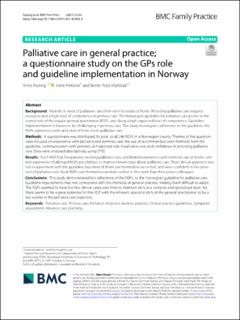| dc.contributor.author | Fasting, Anne | |
| dc.contributor.author | Hetlevik, Irene | |
| dc.contributor.author | Mjølstad, Bente Prytz | |
| dc.date.accessioned | 2022-12-16T09:27:20Z | |
| dc.date.available | 2022-12-16T09:27:20Z | |
| dc.date.created | 2021-06-02T18:04:54Z | |
| dc.date.issued | 2021 | |
| dc.identifier.citation | BMC Family Practice. 2021, 22:64 1-10. | en_US |
| dc.identifier.issn | 1471-2296 | |
| dc.identifier.uri | https://hdl.handle.net/11250/3038196 | |
| dc.description.abstract | Background: Patients in need of palliative care often want to reside at home. Providing palliative care requires resources and a high level of competence in primary care. The Norwegian guideline for palliative care points to the central role of the regular general practitioner (RGP), specifying a high expected level of competence. Guideline implementation is known to be challenging in primary care. This study investigates adherence to the guideline, the RGPs experience with, and view of their role in palliative care. Methods: A questionnaire was distributed, by post, to all 246 RGPs in a Norwegian county. Themes of the questionnaire focused on experience with palliative and terminal care, the use of recommended work methods from the guideline, communication with partners, self-reported role in palliative care and confidence in providing palliative care. Data were analyzed descriptively, using SPSS. Results: Each RGP had few patients needing palliative care, and limited experience with terminal care at home. Limited experience challenged RGPs possibilities to maintain knowledge about palliative care. Their clinical approach was not in agreement with the guideline, but most of them saw themselves as central, and were confident in the provision of palliative care. Rural RGPs saw themselves as more central in this work than their urban colleagues. Conclusions: This study demonstrated low adherence of the RGPs, to the Norwegian guideline for palliative care. Guideline requirements may not correspond with the methods of general practice, making them difficult to adopt. The RGPs seemed to have too few clinical cases over time to maintain skills at a complex and specialized level. Yet, there seems to be a great potential for the RGP, with the inherent specialist skills of the general practitioner, to be a key worker in the palliative care trajectory. | en_US |
| dc.language.iso | eng | en_US |
| dc.publisher | BioMed Central | en_US |
| dc.relation.uri | https://bmcprimcare.biomedcentral.com/articles/10.1186/s12875-021-01426-8 | |
| dc.rights | Navngivelse 4.0 Internasjonal | * |
| dc.rights.uri | http://creativecommons.org/licenses/by/4.0/deed.no | * |
| dc.subject | Allmennmedisin | en_US |
| dc.subject | General Practice | en_US |
| dc.subject | Palliasjon | en_US |
| dc.subject | Palliative care | en_US |
| dc.title | Palliative care in general practice; a questionnaire study on the GPs role and guideline implementation in Norway | en_US |
| dc.title.alternative | Palliative care in general practice; a questionnaire study on the GPs role and guideline implementation in Norway | en_US |
| dc.type | Peer reviewed | en_US |
| dc.type | Journal article | en_US |
| dc.description.version | publishedVersion | en_US |
| dc.subject.nsi | VDP::Medisinske fag: 700 | en_US |
| dc.subject.nsi | VDP::Midical sciences: 700 | en_US |
| dc.source.pagenumber | 1-10 | en_US |
| dc.source.volume | 22:64 | en_US |
| dc.source.journal | BMC Family Practice | en_US |
| dc.identifier.doi | 10.1186/s12875-021-01426-8 | |
| dc.identifier.cristin | 1913392 | |
| cristin.ispublished | true | |
| cristin.fulltext | original | |
| cristin.qualitycode | 1 | |

